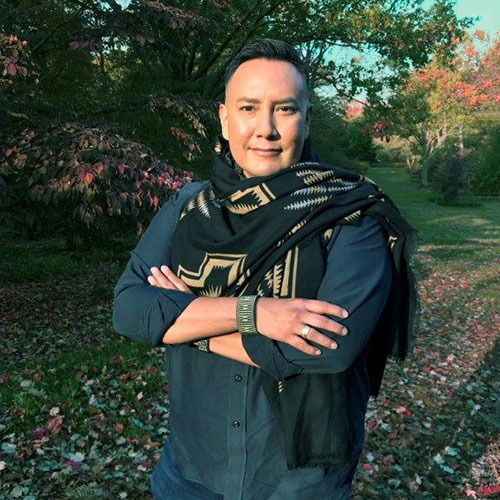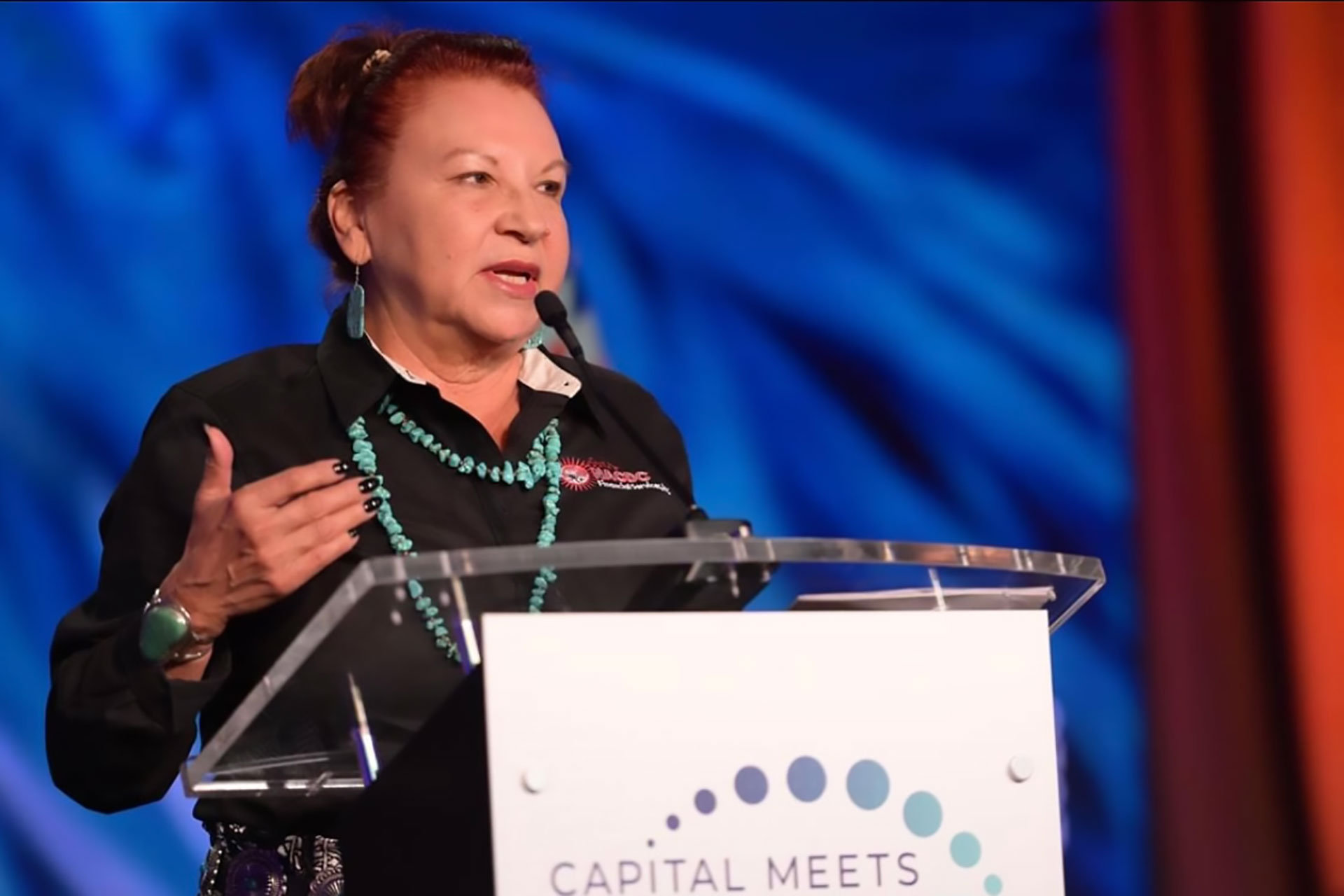By Gabriella Chiarenza
June 17, 2024
Across more than two thousand square miles of Blackfeet Indian Reservation land at the edge of northern Montana, you’ll find a wealth of Native people dreaming of owning their own home. But with few mainstream banks doing much business on or near the reservation, Blackfeet Nation’s citizens struggle to get the home loans they need. It’s a credit access problem that’s persisted for generations.
The tide is turning, though, for Blackfeet homeowners. From within their own community, a small but determined group of experienced lenders stepped forward to cut through red tape and smooth out the uniquely complex process of financing homeownership on a reservation. Since 2011, they’ve run NACDC Financial Services, a Native Community Development Financial Institution (NCDFI) on the reservation in Browning, MT. These lenders are proving that homeownership dreams can come true here.
“We’re dispelling myths about working with reservations, because our staff are doing it,” said NACDC Financial Services’ executive director Angie Main, nodding toward Patty Gobert and Paula Crawford, who run the lending team. “We have 80 home loans in our portfolio. We’re working in areas that mainstream financial institutions don’t touch.”
NCDFIs like NACDC Financial Services are making notable progress even at their smaller scale. But they can’t do it alone. Addressing the vast backlog of unmet Native homeownership interest requires tapping into more financial and technical resources. These enterprising local lenders are calling on their mainstream bank counterparts to help them meet the long-overlooked credit needs of 1.3 million Native people living in American Indian Areas.

Photo courtesy of Opportunity Finance Network and Sam Levitan Photography
Homeownership on trust lands possible with dedicated lenders
Reservations like Blackfeet Nation’s are part of more than 56 million acres of land across the country held in trust for tribes by the federal government. The designation means that building or buying a home on trust land necessarily involves both the Bureau of Indian Affairs (BIA) and the tribe that has jurisdiction in that area.
You also can’t use the land under the home as loan collateral in the same way you might buying a home outside of trust land. Instead, borrowers must secure a land lease—a share of the interest in the land—from the tribe and a title status report that confirms that a home may be built or sited there. There are 574 federally recognized Native Nations, and each has its own policies and processes around use of its land.
These added steps and unique conditions around financing on trust land are part of the reason mainstream financial institutions lend less frequently there. Often, the collateral structure and a particular tribe’s land leasing procedures are unfamiliar to mainstream lenders. The process of securing needed paperwork takes time and requires several interactions with tribal and BIA offices.
With few knowledgeable and willing lenders at hand, aspiring Native homeowners can’t get the loans they seek. As of 2019, about 57 percent of Native households across the country owned homes, compared with nearly 72 percent of white households.
In a recent NeighborWorks America survey, more than half of Native respondents said they were seeking a new place to live. But 80 percent also said that they felt banks would not approve them for a homeownership loan.
“It takes an extra step to educate people on the way that things happen and [to] have specialization in those different areas,” said Mel Willie, Director of Native American Partnerships and Strategy at NeighborWorks and a member of Navajo Nation. “The fact is that [mainstream] lenders do not take that extra step.”

“Native CDFIs are Native people’s advocates. It’s home-grown talent that knows the needs of their community and is able to meet those needs.”
– Mel Willie, director of Native American partnerships and strategy, NeighborWorks America, member of Navajo Nation
Local expertise and partnership required to grow rural Indian Country homeownership
Federally recognized reservations also can stretch over vast, rural territory. The nearest bank may be more than a hundred miles away. The cost and complexity of building new housing and related infrastructure on rural trust land raises additional hurdles. Willie noted that it’s often a struggle to find builders and tradespeople willing to do the work far from their usual sites.
At the same time, the few existing homes can be deteriorating in condition. Limited credit access on reservations means it’s also hard to find loans for needed renovations. In tribal areas, 23 percent of Native households in 2015 faced at least one physical problem with their housing unit, such as issues with plumbing, heating, or electrical systems. By comparison, just five percent of all US households grappled with these housing condition problems.
“We’ve experienced challenges helping homeowners buy existing homes, because there is no housing stock,” said Paula Crawford of NACDC Financial Services.
“At that point, we have to get creative and possibly find land so we could actually bring a manufactured home there, or build a new home from scratch,” she continued. “I’ve been out trying to find contractors that are reputable and will help us in building homes.”
Native CDFIs step in to lend where others don’t
This vital adaptability lies at the center of NCDFIs’ approach to their work. Community development financial institutions are mission-driven lenders dedicated to providing financial services where mainstream lenders may not. They often serve communities of color, lower-income communities, and others historically overlooked by banks.
As of October 2023, seventy certified NCDFIs provide services, credit, and capital across Indian Country. Broadly defined, Indian Country includes the places where Native people have lived and continue to thrive. Sometimes located on reservations, NCDFIs are typically led and staffed by members of the communities they serve.
NACDC Financial Services, for example, serves Native people across Montana from its headquarters in Blackfeet Nation, and has made loans in Native communities in five neighboring states. All of its staff members are Native. Main, Gobert, and Crawford are enrolled members of area tribes—Fort Belknap Gros Ventre, Blackfeet, and Rosebud Sioux of South Dakota, respectively.
“Native CDFIs are Native people’s advocates,” said Willie. “It’s home-grown talent that knows the needs of their community and is able to meet those needs.”

“NCDFIs design their products keeping in mind the actual needs of the people they serve. They go to a greater length to make sure that the products are working.”
– Michou Kokodoko, project director, Center for Indian Country Development at the Minneapolis Fed
Driving successful lending with cultural awareness and a creative approach
NCDFI leaders’ shared cultural roots and understanding of their communities’ interests deeply inform their unique lending approaches. Their nontraditional structure enables them to carry out that lending in necessarily creative and flexible ways. They are not regulated in the same way as mainstream financial institutions.
“NCDFIs design their products keeping in mind the actual needs of the people they serve,” said Michou Kokodoko, Project Director in the Center for Indian Country Development at the Minneapolis Fed. “They go to a greater length to make sure that the products are working.”
Staff find a wide range of ways to meet clients’ collateral needs. Importantly, NCDFIs also emphasize building relationships with their clients throughout the loan process, connecting them (often in-house) with information and additional credit support they may need along the way.
“Each and every customer who comes through the door is unique,” said NACDC’s Crawford. “If we have to do a credit-builder loan or consolidate some of their credit cards to make it more affordable, we will do that.”
Crawford explained that NACDC Financial Services has even put liens on a car or truck to use as collateral for a home loan. “We’ve been really successful in helping families get into homes,” she said. “Whatever the scenario is, we just get creative as we go along.”
Ensuring borrowers don’t miss out on homeownership
Most NCDFIs are nonprofit organizations with responsibilities to their funders. Like any lender, they must do their due diligence and lend responsibly.
While they follow typical procedures for appraising properties and analyzing loan applications, though, NACDC’s Gobert said a unique strength NCDFIs bring to the process is their persistence. For NACDC, that long-term work included building a relationship with the local BIA office and following up.
“As go-getters, we’ve cleared the path for homeownership on trust land here with the BIA, and it’s because we have the patience,” Gobert explained. “We have the desire to have our customers have a home, and we have the endurance to keep pushing [for that outcome].”
Studies underscore the difference NCDFIs make in their communities. For example, research from the Center for Indian Country Development (CICD) at the Minneapolis Fed shows these lenders’ presence and work positively impact community credit scores and help to reduce loan failure. NCDFIs’ experiences provide vital guidance for scholars and other lenders on how to lend inclusively in Native communities.
The team at NACDC Financial Services pointed out that they take pride in countering misperceptions around lending in Indian Country. “I work with many borrowers that are very sophisticated and have good credit,” said Crawford. “A lot of people assume: ‘people on the reservation all have bad credit.’ That’s not true. They’re good-paying customers with jobs.”
“We’re dispelling myths, like Angie said,” she added.

“We do home loans on trust land, and we maintain a zero percent default rate. Why not go to the people who know how to do all of this? We have experts that have been in the field for years.”
– Angie Main, executive director, NACDC Financial Services
What NCDFIs need to continue to support Native homeownership on trust land
Crawford, Gobert, and Main said their clients commend them on their ability to act as a “one-stop shop,” offering a variety of loan products and services that align with the community’s needs. They’re proud hearing this community feedback, they said, but like many NCDFIs, they are trying to do as much as they can within tight resources.
“Our biggest challenge is having limited funding,” Main said. “As soon as we get a million in, it goes right out the door. Not only do we need to look for money to be able to relend to our customers, we also have to keep staff on board. So, you’re continually looking for funding.”
Main feels it’s important for those designing loan programs intended for Indian Country to work closely with knowledgeable NCDFIs. Collaboration ensures that the resulting products are a good fit for more communities.
“We do home loans on trust land, and we maintain a zero percent default rate,” Main said. “Why not go to the people who know how to do all of this? We have experts that have been in the field for years.”
Building capacity and scaling up a unique approach
Based on research interviews with NCDFIs, the Minneapolis Fed’s Kokodoko added that these small lenders are now figuring out how to grow and adapt without burning out. Doing so may require them to work in partnership in new ways with mainstream lenders and other service providers.
“Day by day, for the most part, they do everything in-house,” Kokodoko said. “To ensure future sustainability, it’s critical to continue evaluating the tradeoff between keeping everything in-house and wanting to outsource or using fees for service.”
NCDFIs also have had difficulty getting their nonstandard loans onto the secondary market. Doing so would help to free these lenders up to then make additional new loans.
“Some institutions like GSEs, for example, are trying to work with NCDFIs to see if some of them can eventually be a broker or an approved seller,” he added. “Having the opportunity to sell those loans and have some liquidity to do more in the community could increase impact for groups like NACDC.”

“At the end of the day, it’s so rewarding to be in this position. It’s so rewarding for the homebuyer as well, because they have stability. They show their children and others around them that it could be done. That’s what makes our phones ring.”
– Paula Crawford, NACDC Financial Services
Trusting the community to invest in what it needs most
As they navigate these day-to-day stresses and longer-term growth pain points, Native CDFIs persist in providing their unique onramp to Native homeownership. To reverse course after generations were left behind and overlooked by the mainstream lending system, they’ve created their own approach to delivering the kind of credit and support their communities need and want.
Mel Willie emphasized that for Native people, home is much more than just shelter. “You practice your cultural traditions and spiritual ways out of your home,” he explained. “If you have a Native family that’s constantly couch-surfing, they’re never able to focus on those things that are most important to the preservation of the Native people of this land—and that’s culture, language, and traditions.”
The experienced lenders at NACDC have seen what it means to their community to have their own people walking hand in hand with them to the homeownership finish line. It has a generational effect.
“We’ve seen our parents and grandparents go through all of the challenges of working with the bank,” said Main. “They’ve never had these opportunities before, to work with a CDFI where there’s actually a Native American that’s going to help you. That trust is built in right away, because we’re members of these communities.”
“At the end of the day, it’s so rewarding to be in this position,” added Crawford. “It’s so rewarding for the homebuyer as well, because they have stability. They show their children and others around them that it could be done. That’s what makes our phones ring.”